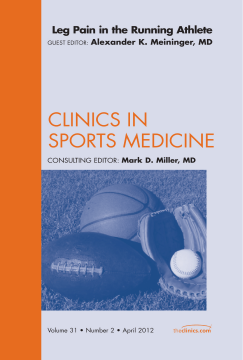
BOOK
Leg Pain in the Running Athlete, An Issue of Clinics in Sports Medicine - E-Book
(2012)
Additional Information
Book Details
Abstract
This issue of Clinics in Sports Medicine, Guest Edited by Alexander K. Meininger, MD, is devoted to Leg Pain in Athletes. Leg pain is a common manifestation of many ailments for which the athlete is vulnerable. In this issue, authors will discuss the most common causes of leg pain, including tibial stress syndrome, stress fractures, and exertional compartment syndrome. Attention will also be given to the evaluation of the injured runner, risk factors (such as the female athlete triad), and useful imaging adjuncts will be discussed.
Table of Contents
| Section Title | Page | Action | Price |
|---|---|---|---|
| Front Cover | Cover | ||
| Leg Pain in the Running\rAthlete | i | ||
| Copyright Page | ii | ||
| Table of Contents | v | ||
| Contributors | iii | ||
| Foreword | xi | ||
| Preface | xiii | ||
| Chapter 1. The Anatomy and Biomechanics of Running | 187 | ||
| RUNNING GAIT CYCLE | 187 | ||
| THE KINETIC CHAIN OF RUNNING | 191 | ||
| EVALUATION | 196 | ||
| KINETIC CHAIN | 199 | ||
| SUMMARY | 199 | ||
| REFERENCES | 199 | ||
| Chapter 2. Evaluation of the Injured Runner | 203 | ||
| HISTORY | 203 | ||
| PHYSICAL EXAMINATION | 204 | ||
| GAIT | 210 | ||
| CORE STABILITY AND BALANCE | 211 | ||
| SUMMARY | 214 | ||
| REFERENCES | 214 | ||
| Chapter 3. Diagnostic Imaging in the Evaluation of Leg Pain in Athletes | 217 | ||
| STRESS INJURY TO BONE | 217 | ||
| ACHILLES TENDON INJURIES IN RUNNERS | 220 | ||
| INJURY TO THE HAMSTRING MUSCLE COMPLEX | 227 | ||
| EXERTIONAL COMPARTMENT SYNDROME | 230 | ||
| POPLITEAL ARTERY ENTRAPMENT SYNDROME | 235 | ||
| SUMMARY | 239 | ||
| REFERENCES | 242 | ||
| Chapter 4. The Female Athlete Triad | 247 | ||
| PREVALENCE | 247 | ||
| ETIOLOGY | 248 | ||
| RISK FACTORS | 248 | ||
| ENERGY AVAILABILITY | 249 | ||
| MENSTRUAL DYSFUNCTION | 249 | ||
| BONE MINERAL DENSITY | 250 | ||
| EVALUATION | 251 | ||
| PREVENTION AND TREATMENT | 252 | ||
| SUMMARY | 253 | ||
| REFERENCES | 254 | ||
| Chapter 5. Muscle Soreness and Delayed-Onset Muscle Soreness | 255 | ||
| CLINICAL PRESENTATION | 255 | ||
| CELLULAR MECHANISMS | 256 | ||
| PREVENTIVE MEASURES | 257 | ||
| SYMPTOM MANAGEMENT | 257 | ||
| SUMMARY | 258 | ||
| REFERENCES | 258 | ||
| Chapter 6. Hamstring Strains and Tears in the Athlete | 263 | ||
| ANATOMY | 263 | ||
| DIAGNOSIS | 264 | ||
| CLASSIFICATION | 265 | ||
| TREATMENT | 266 | ||
| SUMMARY | 270 | ||
| REFERENCES | 270 | ||
| Chapter 7. Medial Tibial Stress Syndrome | 273 | ||
| INTRODUCTION | 273 | ||
| RELATED PATHOANATOMY AND PATHOPHYSIOLOGY | 273 | ||
| RISK FACTORS | 275 | ||
| PATIENT EVALUATION | 278 | ||
| TREATMENT | 282 | ||
| PREVENTION | 283 | ||
| SUMMARY | 286 | ||
| REFERENCES | 286 | ||
| Chapter 8. Stress Fractures in Runners | 291 | ||
| PATHOPHYSIOLOGY | 291 | ||
| RISK FACTORS | 292 | ||
| EVALUATION | 295 | ||
| HIGH-RISK STRESS FRACTURES | 296 | ||
| LOW-RISK STRESS FRACTURES | 301 | ||
| TREATMENT AND PREVENTION STRATEGY | 302 | ||
| SUMMARY | 303 | ||
| REFERENCES | 303 | ||
| Chapter 9. Chronic Exertional Compartment Syndrome | 307 | ||
| ANATOMY | 308 | ||
| PATHOPHYSIOLOGY | 309 | ||
| EVALUATION | 309 | ||
| DIAGNOSTIC TESTING | 310 | ||
| TREATMENT | 312 | ||
| OUTCOMES | 315 | ||
| COMPLICATIONS | 316 | ||
| SUMMARY | 316 | ||
| REFERENCES | 316 | ||
| Chapter 10. Popliteal Entrapment in Runners | 321 | ||
| PATIENT WORKUP | 322 | ||
| RESULTS | 324 | ||
| DISCUSSION | 325 | ||
| REFERENCES | 327 | ||
| Chapter 11. Tendinopathy Treatment: Where is the Evidence? | 329 | ||
| PREVALENCE | 329 | ||
| PATHOPHYSIOLOGY | 330 | ||
| PHARMACOTHERAPY | 330 | ||
| ECCENTRIC EXERCISE | 334 | ||
| EXTRACORPOREAL SHOCK WAVE THERAPY | 334 | ||
| INJECTION THERAPY | 336 | ||
| OPERATIVE MANAGEMENT | 340 | ||
| AUTHORS’ PREFERRED TECHNIQUE | 341 | ||
| SUMMARY | 341 | ||
| REFERENCES | 343 | ||
| Chapter 12. Rehabilitation of Running Injuries | 351 | ||
| INITIAL STRATEGIES | 351 | ||
| ULTRASOUND | 354 | ||
| BONE STIMULATORS | 354 | ||
| MASSAGE | 354 | ||
| BRACING (SEE PROTECTION) | 355 | ||
| TAPING | 355 | ||
| INJECTIONS | 355 | ||
| FOOTWEAR | 356 | ||
| STRENGTHENING | 357 | ||
| FLEXIBILITY | 357 | ||
| BALANCE | 358 | ||
| MAINTENANCE OF FITNESS—CROSS TRAINING | 359 | ||
| RUNNING SKILLS AND DRILLS | 359 | ||
| RETURN TO RUNNING | 359 | ||
| SPECIFIC INJURIES | 361 | ||
| SUMMARY | 368 | ||
| REFERENCES | 368 | ||
| Index | 373 |
